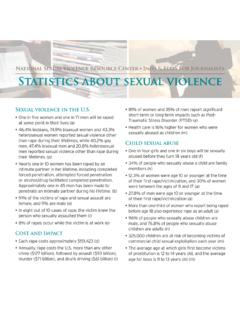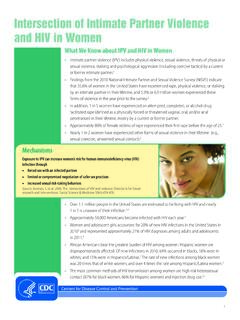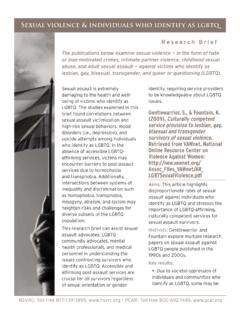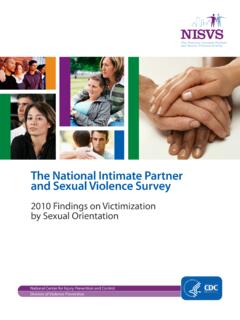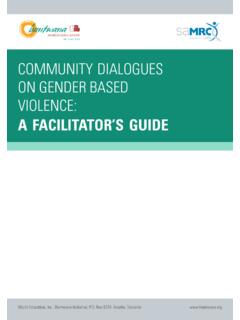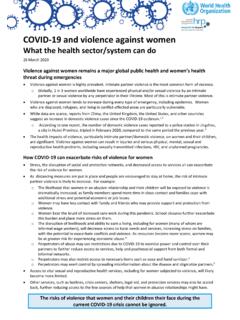Transcription of ASSESSING PATIENTS FOR SEXUAL VIOLENCE
1 ASSESSING PATIENTS FOR SEXUAL VIOLENCEA GUIDE FOR HEALTH CARE PROVIDERSThis project was supported by Grant Number 2009-TA-AX-K042, awarded by the Office on VIOLENCE Against Women, Department of Justice. The opinions, findings, conclusions, and recommendations expressed in this publication are those of the author(s) and do not necessarily reflect the views of the Department of Justice, Office on VIOLENCE Against content of this publication may be reprinted with the following acknowledgement: This material was reprinted, with permission, from the National SEXUAL VIOLENCE Resource Center s publication entitled ASSESSING PATIENTS for SEXUAL VIOLENCE : A guide for health care providers.
2 This guide is available by visiting National SEXUAL VIOLENCE Resource Center 2011. All rights Guide for Health Care Providers 1 SEXUAL VIOLENCE is a common experience in the lives of women and men. Current estimates suggest that one in six women and one in 33 men will experience attempted or completed rape ( , forced oral, anal, or vaginal penetration) in his or her lifetime (Tjaden & Thoennes, 1998). People who have been sexually victimized are more likely to suffer from chronic physical and mental health problems than those who have not been victimized, and believe that their health is fair or poor (Golding, Cooper, & George, 1997).
3 Female survivors of SEXUAL VIOLENCE visit the doctor more often than women who have not been victimized (Rosenberg et al., 2000). Given the high rates of SEXUAL VIOLENCE and potential health impacts, it is therefore likely that most health care providers will come into contact with victims of SEXUAL variety of tools and guidelines have been created Many prominent health organizations recommend to address the need for screening PATIENTS for that providers screen their PATIENTS for VIOLENCE , histories of SEXUAL VIOLENCE . This guide aims including the American Medical Association, the to build on those tools and encourage health care World Health Organization, the American College providers to conduct full assessments with PATIENTS of Obstetricians and Gynecologists, the American to encourage interventions that provide adequate Academy of Pediatricians, and the American treatments and recommendations for survivors Nurses Association (Stevens, 2007).
4 Of SEXUAL most of the current research ASSESSING patientsand recommendations regarding screening PATIENTS for SEXUAL VIOLENCE focuses on women, While studies have shown that most female some programs have begun screening both PATIENTS want to be asked about their experiences male and female PATIENTS with promising with SEXUAL VIOLENCE by their health care results. The Veterans Health Administration providers (Littleton, Berenson, & Breitkopf, 2007), recently implemented a universal screening few medical professionals screen any PATIENTS , program for male and female veterans that female or male, for such trauma (McAfee, 1995).
5 Provides free care for any patient experiencing This may be due to a lack of training, time, or conditions resulting from military SEXUAL comfort on the part of the health care provider trauma (Kimerling, Street, Gima, & Smith, (Stayton & Duncan, 2005). However, doctors 2008). The program found that both men offices can be safe, confidential places to address and women who screened positive for military SEXUAL VIOLENCE in which survivors can feel SEXUAL trauma were more likely to seek out comfortable disclosing and confident in mental health care after being screened than receiving the care and services they need.
6 Those who screened PATIENTS FOR SEXUAL VIOLENCEA GUIDE FOR HEALTH CARE PROVIDERSHow to discuss SEXUAL VIOLENCE Normalize the Topic I need to ask you some personal questions. Asking these questions can help me care for you better. Since I am your doctor, we need to have a good partnership. I can better understand your health if you would answer some questions about your SEXUAL history. I ask all of my PATIENTS this question because it is important for me to know what has gone on in their context to your questions We know that SEXUAL VIOLENCE is common in the lives of many women, men, girls, and boys.
7 Connect SEXUAL VIOLENCE to the patient s physical health and well being SEXUAL VIOLENCE can affect a person s health. Ask about SEXUAL experiences that were unwanted or made the person feel uncomfortable Have you ever been touched sexually against your will or without your consent? Have you ever been forced or pressured to have sex? Do you and your partner ever disagree about SEXUAL things? Like what? How do you resolve these conflicts? Do you feel that you have control over your SEXUAL relationships and will be listened to if you say no to having sex?
8 (Pennsylvania Coalition Against Rape [PCAR], 2005) 2 ASSESSING PATIENTS for SEXUAL ViolenceScreening PATIENTS is only one step in the process. A full assessment requires that health care providers also develop plans and protocols for what to do when a patient discloses incidents of SEXUAL assessment protocolsHealth care providers should develop protocols that ensure consistent, effective practices for providing care to PATIENTS that experience SEXUAL VIOLENCE . One promising tool that can aid providers in these efforts is the SAV E method, which was developed by the Florida Council Against SEXUAL VIOLENCE (2003).
9 YScreen all of your PATIENTS for SEXUAL VIOLENCE yAsk direct questions in a non-judgmental way yValidate your patient s response yEvaluate, educate and make referralsProtocols should stipulate that PATIENTS be assessed regularly ( , annually), as this will give PATIENTS multiple chances to disclose victimization and allow time for the patient to develop a trusting relationship with the provider (Stevens, 2007). Medical providers are encouraged to consider their professional ethics and organizational policies in order to form protocols which safeguard the privacy of victims and survivors in every aspect of their practice, including documentation and information sharing with other providers.
10 The decision to document disclosures of SEXUAL VIOLENCE , in particular, should be carefully considered. Trainings and consultations for medical providers on this topic are available through SEXUAL VIOLENCE prevention and services centers and state coalitions against SEXUAL VIOLENCE . A Guide for Health Care Providers 3 Health care providers should avoid Asking PATIENTS about their victimization when other people are present Only asking PATIENTS who seem like victims about their experiences Using the term rape, as some survivors may not label their experience as rape (Pittsburgh Action Against Rape, 2007) Using formal, technical, or medical jargon (Stevens, 2007) Only asking about specific types of VIOLENCE or recent VIOLENCE (PCAR, 2005)

